Gaps in teeth can be a source of self-consciousness and embarrassment for some people. But, with modern cosmetic dentistry options, it is possible to fix gaps in teeth and regain the beautiful smile you have always wanted. In this article, we will discuss the different ways you can fix gaps in your teeth, including braces, veneers, and bonding. We’ll also discuss the cost and timeline associated with each treatment option so that you can make an informed decision about how to best fix your gap in teeth.Dental bonding is a cosmetic dental procedure that can be used to fix gaps in teeth. It involves the application of a tooth-colored composite resin material to the teeth, which is then hardened with a special light. The dentist will then shape and polish the material, so that it looks like your natural teeth. This procedure typically takes around 30 minutes to complete and results are usually immediate. It is also a less expensive option than other treatments, such as veneers. To fix gaps in teeth using dental bonding, you should first visit your dentist for an evaluation of your teeth and gums. Your dentist can then discuss the best option for you based on your individual needs and preferences.
How To Fill A Gap In Teeth With Dental Veneers
Gaps between teeth can be a source of embarrassment and can affect self-confidence. Fortunately, there are solutions available to fill the gap. One of the most popular methods is dental veneers. Dental veneers are thin shells made from porcelain or composite resin that attach to the front of a tooth. They are custom-made to fit each patient’s mouth and provide a natural-looking appearance. They can also help protect teeth from further damage and decay.
The process for getting dental veneers usually begins with an initial consultation with your dentist. During this visit, your dentist will evaluate the size and shape of the gap in your teeth, as well as discuss what type of material would best suit your needs. The dentist will then take an impression of your mouth in order to create the custom veneer that will fit snugly over your tooth.
Once the veneer is ready, your dentist will bond it onto your tooth using a special adhesive. This process may require several visits for adjustments and additional bonding if necessary. After the procedure is complete, you should see immediate results in terms of aesthetics; however, it may take some time before you get used to the feeling of having a foreign object attached to your teeth.
It is important to note that dental veneers require regular maintenance in order to keep them looking their best and prevent any damage or decay from occurring. You should brush twice daily, floss regularly, and visit your dentist every six months for checkups and cleanings. Additionally, you may need to have periodic touch-ups done by your dentist if your veneers become stained or worn down over time.
Overall, dental veneers are an excellent solution for those who want to fill gaps between their teeth and improve their overall smile aesthetics without opting for more extensive procedures such as braces or implants. With proper care and regular maintenance, they can last up to 10 years or longer!
What Is The Best Way To Close Gaps In Teeth?
Closing gaps in teeth is an important part of maintaining oral health. There are several options available to close gaps in teeth, each with its own advantages and disadvantages. The best option for an individual depends on the size and location of the gap, as well as the patient’s overall oral health.
The most common way to close gaps in teeth is through orthodontic treatment. Orthodontists can use braces or clear aligners to move the teeth into their proper positions, closing any gaps that exist. This is a more permanent solution than other methods, but it can take several months or even years to achieve desired results.
Another option for closing gaps in teeth is bonding. This involves applying a tooth-colored material to the front of the tooth and sculpting it into the desired shape. Bonding can be used to fill small gaps in teeth, but it is not a permanent solution and may need to be redone every few years.
Dental veneers are another option for closing gaps in teeth. Veneers are thin shells that are bonded onto the front surfaces of the teeth, covering any existing imperfections such as gaps between them. Veneers offer a more permanent solution than bonding but they may require multiple visits to complete and they can be expensive.
Finally, dental implants can be used to close gaps between teeth by replacing missing or damaged teeth with artificial replacements that look and feel like natural ones. Dental implants provide a more permanent solution than other options and they are also durable, but they require surgery and they can be costly.
The best way to close gaps in teeth depends on an individual’s specific needs and situation. Orthodontic treatment, bonding, veneers, or dental implants can all be used to close gaps between teeth depending on what works best for each person’s situation. Consulting with an experienced dentist is the best way to determine which option will provide the best results for an individual’s particular needs.

Is It Possible To Fix Gaps In Teeth Without Braces?
Yes, it is possible to fix gaps in teeth without braces. Depending on the severity of the gap, there are a few options to consider. For minor gaps, composite bonding can be used to fill the space and make the teeth appear more even. This procedure uses a tooth-colored material to fill in the gap and can be completed in one visit.
For more severe cases, porcelain veneers may be an option. Veneers are thin shells that are attached to the front of teeth and cover any imperfections. They give a natural look and can last for several years when properly cared for.
In some cases, crowns may also be used to fix gaps between teeth. Crowns fit over existing teeth and help support them while also providing additional stability. This is usually recommended if there are no other options available or if a patient prefers a long-term solution.
Ultimately, it is up to your dentist or orthodontist to determine which treatment option is best for you based on your individual needs and preferences. They will be able to provide more information on what will work best for your particular situation.
No matter which option you choose, it is important to practice good oral hygiene habits such as brushing twice daily and flossing at least once per day in order to keep your smile healthy and looking its best.
How To Fix A Gap In Teeth With Orthodontic Treatment
Having a gap in your teeth can make you feel self-conscious about your smile, but the good news is that you can repair it with orthodontic treatment. Orthodontics is a branch of dentistry that focuses on aligning the teeth and jaws to create a better-looking smile and improved oral health. By correcting misalignment or gaps in teeth, orthodontics can help to restore confidence in your smile.
Orthodontic treatment is tailored to each individual patient depending on their specific needs. The most commonly used treatments for closing a gap between the teeth include braces, clear aligners, and dental bonding. Braces are metal brackets and wires that are cemented onto the teeth and used to move them into place. Clear aligners are removable trays that fit over the teeth and are used to shift them gradually into position over time. Dental bonding is done by applying tooth-colored resin to the gap, which then hardens into place for an instant fix.
The length of time required for orthodontic treatment will depend on the severity of the gap as well as other factors such as age and overall oral health. Generally, braces take 12-24 months while clear aligners take 6-12 months to close gaps in teeth. Dental bonding may be completed within one appointment but may require additional touch-ups over time.
The cost of orthodontic treatment will vary depending on your specific needs and which type of treatment you choose. Braces typically range from $3,000-$7,000 while clear aligners cost around $2,000-$5,000. Dental bonding usually costs around $200-$600 per tooth depending on how much resin is needed for the procedure.
If you have a gap between your teeth and want to restore confidence in your smile, then orthodontic treatment could be an effective option for you. Talk to your dentist about which type of treatment would best meet your needs so that you can get started on closing the gap in your teeth today!
Closing Gaps In Teeth
Closing gaps in teeth can improve the appearance of your smile, boost your self-confidence, and improve your oral health. Having a gap between your teeth can make it difficult to clean them properly and can result in food particles becoming stuck in the gap. This can cause plaque build-up and lead to tooth decay. Closing the gap between your teeth will help to prevent this from happening. It will also make it easier to brush and floss, resulting in better overall oral health.
In addition, closing gaps in teeth can improve the appearance of your smile. Having a gap between your teeth can create an uneven look that may be distracting or even embarrassing for some people. Closing the gap between your teeth will result in an even smile that looks more aesthetically pleasing. This can help to boost self-confidence and make it easier to feel comfortable when interacting with others.
Overall, closing gaps in teeth has many benefits including improved oral health, better aesthetics, and increased self-confidence. If you are considering closing a gap between your teeth, it is important to speak with your dentist first so they can assess whether or not this procedure is right for you.

Conclusion
The most popular and effective way to fix a gap in teeth is to get braces or Invisalign. Braces are the traditional way of closing the gap between teeth, while Invisalign is a modern and less visible option. Other solutions such as dental bonding, veneers, and crowns can also be used to close gaps in teeth.
No matter which option you choose, it is important to speak to your dentist first before proceeding with any treatment. Your dentist will be able to provide you with the best advice based on your individual situation and needs.
Good oral hygiene is also key when it comes to preventing gaps from forming in the future. Regular brushing and flossing can help prevent plaque buildup and cavities, which can lead to gaps in teeth.
Overall, there are many ways that you can fix a gap in your teeth depending on your individual situation. It is important to speak with your dentist first before deciding on a course of action so that they can provide you with the best advice for your particular case. Taking good care of your teeth will also help ensure that any gaps stay closed in the future.
